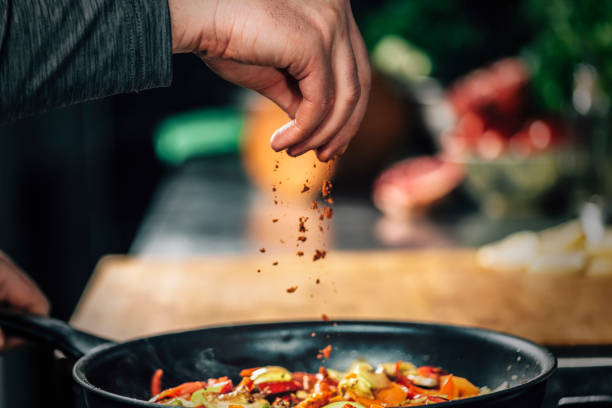Flavor Fusion: The Art of Culinary Crossovers
Embark on a gastronomic journey where culinary traditions collide, creating tantalizing new flavor experiences. From unexpected ingredient pairings to innovative cooking techniques, discover how chefs are pushing the boundaries of taste and texture. Get ready to explore the exciting world of culinary crossovers that are redefining global cuisine.

The Rise of Hybrid Cuisines
As our world becomes increasingly interconnected, so too does our food. Hybrid cuisines are emerging as chefs draw inspiration from multiple culinary traditions to create entirely new flavor profiles. One such example is the rise of “Nikkei” cuisine, a fusion of Japanese and Peruvian flavors that has taken the culinary world by storm. This unique blend combines the clean, precise flavors of Japanese cuisine with the bold, vibrant tastes of Peru, resulting in dishes like tiradito (a Peruvian-style sashimi) or anticuchos made with miso-marinated beef heart. Another exciting hybrid is “Tex-Mex” cuisine, which marries the hearty flavors of Texas barbecue with traditional Mexican dishes. The result? Mouthwatering creations like brisket tacos or jalapeño cornbread. These hybrid cuisines not only showcase the creativity of chefs but also reflect the increasingly diverse and multicultural nature of our societies.
Innovative Cooking Techniques
The fusion of flavors isn’t limited to ingredients alone; innovative cooking techniques are also playing a crucial role in creating culinary crossovers. Chefs are borrowing methods from various cuisines and applying them in unexpected ways. For instance, the French sous-vide technique is now being used to prepare traditionally grilled meats in many Asian restaurants, resulting in incredibly tender and flavorful dishes. Similarly, the ancient Chinese technique of tea-smoking is finding its way into Western kitchens, adding a subtle smoky flavor to everything from salmon to duck. Another intriguing crossover is the use of fermentation techniques from Korean cuisine in creating unique Western-style pickles and preserves. By adopting these diverse cooking methods, chefs are not only expanding their culinary repertoire but also creating entirely new taste experiences for their diners.
Sweet Meets Savory: Dessert Crossovers
The world of desserts is not immune to the trend of culinary crossovers. Pastry chefs are pushing the boundaries by incorporating savory elements into traditionally sweet treats, creating a whole new category of flavor experiences. Imagine biting into a chocolate truffle only to discover a center of blue cheese, or savoring an ice cream flavored with olive oil and sea salt. These unexpected combinations challenge our preconceptions about dessert and open up a world of new possibilities. Another exciting trend is the fusion of different dessert traditions. For example, the cronut, a hybrid of a croissant and a donut, took the world by storm and spawned countless imitations. Similarly, matcha, a traditional Japanese green tea powder, has found its way into everything from ice cream to tiramisu, adding a unique flavor and vibrant color to Western desserts. These sweet and savory crossovers are not only delighting taste buds but also blurring the lines between courses in a meal.
The Role of Technology in Culinary Fusion
Technology is playing an increasingly important role in facilitating culinary crossovers. Advanced kitchen equipment and techniques are allowing chefs to experiment with flavors and textures in ways that were previously impossible. For instance, molecular gastronomy techniques like spherification can transform liquid ingredients into caviar-like spheres, adding an element of surprise and texture to dishes. 3D food printing is another exciting development, enabling chefs to create intricate food structures that combine different flavors and textures in novel ways. Moreover, social media platforms and food blogs are accelerating the spread of culinary ideas across the globe, inspiring chefs and home cooks alike to try new flavor combinations. This rapid exchange of ideas is fueling the culinary crossover trend, leading to an ever-evolving global cuisine that knows no boundaries.
Culinary Crossover Tips & Facts
• Experiment with fusion at home by combining spices from different cuisines in your dishes
• Try pairing ingredients with contrasting flavors, like sweet and spicy or salty and sour
• Don’t be afraid to use unconventional ingredients in familiar recipes
• Learn about different cooking techniques from various cultures to expand your culinary repertoire
• Remember that balance is key when creating fusion dishes – aim for harmony rather than chaos of flavors
• Did you know? The California Roll, now a sushi staple, was created as a way to introduce Americans to Japanese cuisine
As we’ve explored, culinary crossovers are reshaping the global food landscape, challenging our taste buds, and expanding our culinary horizons. From reimagined classics to innovative cooking techniques, these fusions are not just about creating new flavors – they’re about breaking down cultural barriers and fostering a more interconnected world through food. As diners, we have the exciting opportunity to embark on a gastronomic adventure with every meal, discovering new tastes and rediscovering familiar ones in unexpected ways. So the next time you dine out or cook at home, why not embrace the spirit of culinary fusion? You might just create your own delicious crossover that could become the next global food sensation.





